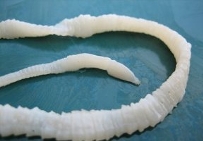BONICE TAPEWORM (TENIARINHOZE)
Biogelmintoz of the groupt sestoz, is characterized by toxic-allergic reactions, dyspeptic disorders. Pathogen - A bullish tapeworm - Taeniarhynchus saginatus, the body which can reach 7-12 m in length, and consists of a head and 1000-2000 segments. It is the largest chain, living in the human body. The territorial spread of the disease is endemic. Significant pockets of teniarinhoze - in Africa, South America, Australia, Southeast Asia, Eastern Europe, Caucasus and Central Asian republics, in the Urals and Siberia.
Sources:
Source of infection is cattle, as well as a sick man, which plays a major role in the spread of bovine tapeworm eggs. Perhaps part of flies in the transmission of the parasite.
Forms of transmission:
The natural susceptibility of people is high. People become infected by eating raw, half-baked, salted and dried meat, raw minced meat containing tapeworm larvae (Finns).
Forms of existence:
The life cycle is the change of the two owners of cattle (intermediate host) and humans (final). In the small intestine of man swallowed the Finns for 3 weeks developed sexually mature worms, which lays eggs excreted in faeces in the environment. Of eggs caught in the intestines of cattle, are exempt oncosphere (embryos) that penetrate the blood vessels and blood flow recorded in the skeletal, chewing, heart muscle, which turn into larvae (the Finns). Man, eating infected meat, continues the life cycle of tapeworm.
Outside the host helminth eggs can be stored up to a month. In the body of an infected animal pathogen persists throughout his life. Feature of the bovine tapeworm is the ability to separate the mature segments filled with eggs, which can move independently and each has its own reproductive system. At the same time they scatter thousands of eggs. If you do not get rid of this parasite, it can survive in the human intestine over 20 years, producing annually up to 600 million eggs, but for the entire life cycle - 11 billion eggs.
Symptoms:
The incubation period lasts from 8 to 14 weeks but may last for several years. Teniarinhoze often takes almost no symptoms. In the early stage of disease expressed in allergic phenomena. The signs of the disease are tapeworm segments allocation in the faeces. Other symptoms: hypochromic anemia, weakness, dizziness, irritability, dyspeptic syndrome: disorders of appetite, nausea, vomiting, diarrhea, or delay the chair, may cramping in the abdomen.
The consequences of getting parasited:
Bovine tapeworm can infest the human body to a few tens of years. Wandering larvae can develop in various organs and can cause appendicitis, cholangitis, cholecystitis, pancreatitis. Tapeworm their suckers affect the integrity of the intestinal wall, producing mechanical damage, produces toxins that have a strong toxic-allergic effects on the human body, but also has a reflex effect on the host, inhibiting the process of digestion in the intestine and stomach. The larvae penetrate the central nervous system, causing blockage and inflammation of the brain vessels, and this leads to increased intracranial pressure syndromes, epilepsy, hydrocephalus, mental illness.
Methods of diagnosis:
The diagnosis is established on the basis of clinical symptoms, detection of bovine tapeworm segments in faeces patient.
"DETA-AP" AFFECTING MICROBES, HELMINTES AND BACTERIAS:

I WISH YOU SUCCESSFUL TREATMENT AND GOOD HEALTH!

